A Multi-Zone Staged Indoor Emergency Evacuation Algorithm Based on Time Equalization
Abstract
:1. Introduction
2. Related Work
3. Methodology
- Add non-exit nodes to array M, and create an empty array B;
- Add a virtual node, which connects to all exits, and the length of new arcs is set to 0;
- The virtual node is set as the search starting node;
- Use Tarjan’s algorithm to search a cut vertex in the unvisited nodes, then mark the visited nodes;
- If there is a cut vertex, go to the next step; otherwise, break;
- Except for the cut vertex, add all nodes in the bi-connected component to the array B, return step (4).
- Determine the currently extended node g and the corresponding exit E (details about this are described in the next section);
- Select the group closest to the exit E in the array B;
- If , go to the next step;
- Calculate the delay time of the group , and update the occupancy time of the exit E with the evacuation time of the group ;
- Remove the group from arrays M and B, return step (2).
4. Algorithm
4.1. Algorithm Idea
4.2. Algorithm Description
- Node operation, get arrays M and B;
- Initialize the occupancy time of each exit as zero;
- Select the exit E with the smallest occupancy time value, then use the Dijkstra algorithm to find the group g closest to E in M;
- Calculate the delay time of g, remove g from arrays M and B, then update the occupancy time of the exit E;
- If there is a node in the array B, go to the next step; otherwise, go to (7);
- Group merging, seen as the previous section for specific steps;
- If there is a node in the array M, go to (3); otherwise, go to the next step;
- Calculate TET.
4.3. Performance Evaluation Index
4.4. Time Complexity
5. Case Study
5.1. Single-Exit Network Evacuation Experiment
5.1.1. Influence of Evacuation Density on TET
5.1.2. Influence of Number of Groups on Efficiency of Algorithms
5.2. Multi-Exit Network Evacuation Experiment
5.2.1. Influence of Distribution of Occupants on Evacuation Efficiency
5.2.2. Influence of Evacuation Density on Evacuation Efficiency
5.2.3. Influence of Exit Capacity on Evacuation Efficiency
5.2.4. Evacuation Process Simulation
6. Conclusions
Author Contributions
Funding
Data Availability Statement
Conflicts of Interest
References
- Murray-Tuite, P.; Wolshon, B. Evacuation transportation modeling: An overview of research, development, and practice. Transp. Res. Part C Emerg. Technol. 2013, 27, 25–45. [Google Scholar] [CrossRef]
- Gao, J.; Zhang, J.; He, J.; Gong, J.; Zhao, J. Experiment and simulation of pedestrian’s behaviors during evacuation in an office. Physica A 2020, 545, 123749. [Google Scholar] [CrossRef]
- Kodur, V.K.R.; Venkatachari, S.; Naser, M.Z. Egress Parameters Influencing Emergency Evacuation in High-Rise Buildings. Fire Technol. 2020, 56, 2035–2057. [Google Scholar] [CrossRef]
- Rozo, K.R.; Arellana, J.; Santander-Mercado, A.; Jubiz-Diaz, M. Modelling building emergency evacuation plans considering the dynamic behavious of pedestrians using agent-based simulation. Saf. Sci. 2019, 113, 276–284. [Google Scholar] [CrossRef]
- Liu, H.; Xu, B.; Lu, D.J.; Zhang, G.J. A path planning approach for crowd evacuation in buildings based on improved artificial bee colony algorithm. Appl. Soft Comput. 2018, 68, 360–376. [Google Scholar] [CrossRef]
- Li, X.; Li, Q.; Xu, X.; Xu, D.; Zhang, X. A novel approach to developing organized multispeed evacuation plans. Trans. GIS 2018, 22, 1205–1220. [Google Scholar] [CrossRef]
- Cheng, Y.; Zheng, X.P. Can cooperative behaviors promote evacuation efficiency? Physica A 2018, 492, 2069–2078. [Google Scholar] [CrossRef]
- Yang, L.Z.; Zhao, D.L.; Li, J.; Fang, T.Y. Simulation of the kin behavior in building occupant evacuation based on Cellular Automaton. Build. Environ. 2005, 40, 411–415. [Google Scholar] [CrossRef]
- Wang, J.H.; Chen, M.M.; Yan, W.Y.; Zhi, Y.R.; Wang, Z.R. A utility threshold model of herding–panic behavior in evacuation under emergencies based on complex network theory. Simulation 2017, 93, 123–133. [Google Scholar] [CrossRef] [Green Version]
- Zheng, X.P.; Cheng, Y. Conflict game in evacuation process: A study combining Cellular Automata model. Physica A 2011, 390, 1042–1050. [Google Scholar] [CrossRef]
- Yang, X.X.; Yang, X.L.; Wang, Q.L. Pedestrian evacuation under guides in a multiple-exit room via the fuzzy logic method. Commun. Nonlinear Sci. Numer. Simul. 2019, 83, 105138. [Google Scholar] [CrossRef]
- Guo, H.X.; Zeng, Y.; Chen, W.M. Research on indoor emergency evacuation simulation of multi-exit based on social force model. J. Syst. Simul. 2021, 33, 721–731. [Google Scholar]
- Wang, J.; Guo, J.; Wu, X.M.; Guo, X.H. Study on intelligent algorithm of guide partition for emergency evacuation of a subway station. IET Intell. Transp. Syst. 2020, 14, 1440–1446. [Google Scholar] [CrossRef]
- Lei, Y.; You, L.; Wu, Q.H.; Wei, J.; Hu, J.; Wang, J.; Liang, Y. A study of pedestrian evacuation model of impatient queueing with cellular automata. Phys. Scr. 2020, 95, 095211. [Google Scholar]
- Jin, B.W.; Wang, J.H.; Wang, Y.; Gu, Y.M.; Wang, Z.R. Temporal and spatial distribution of pedestrians in subway evacuation under node failure by multi-hazards. Saf. Sci. 2020, 127, 104695. [Google Scholar] [CrossRef]
- Xu, X.; Shi, C.L.; Wu, B.B.; He, L. Study on the optimization algorithm of the crowd partition evacuation. J. Saf. Sci. Technol. 2016, 12, 153–158. [Google Scholar]
- Yue, H.; Zhang, B.Y.; Shao, C.F.; Xing, Y. Exit selection strategy in pedestrian evacuation simulation with multi-exits. Chin. Phys. B 2014, 23, 050512. [Google Scholar] [CrossRef]
- Kurdi, H.; Almulifi, A.; Al-Megren, S.; Youcef-Toumi, K. A Balanced Evacuation Algorithm for Facilities with Multiple Exits. Eur. J. Oper. Res. 2020, 289, 285–296. [Google Scholar] [CrossRef]
- Jin, L.H.; Yi, X.Y.; Yin, S.P.; Chen, S.; Zheng, X.Z.; Wang, Y.L. Study on topological analysis model of streamline load for crowd evacuation in public buildings. J. Saf. Sci. Technol. 2020, 16, 30–36. [Google Scholar]
- Ding, Y.C.; Yang, L.Z.; Weng, F.L.; Fu, Z.J.; Rao, P. Investigation of combined stairs elevators evacuation strategies for high rise buildings based on simulation. Simul. Model. Pract. Theory 2015, 53, 60–73. [Google Scholar] [CrossRef]
- Chen, X.F.; Yu, J.Q. A comparative study on safety evacuation strategies for super high rise office buildings. Fire Sci. Technol. 2017, 36, 610–612. [Google Scholar]
- Zhang, J.H.; Liu, Y.; Zhao, Y.X.; Deng, T.H. Emergency evacuation problem for a multi-source and multi-destination transportation network: Mathematical model and case study. Ann. Oper. Res. 2018, 291, 1153–1181. [Google Scholar] [CrossRef]
- Li, X.; Li, Q.P.; Claramunt, C. A time-extended network model for staged evacuation planning. Saf. Sci. 2018, 108, 225–236. [Google Scholar] [CrossRef]
- Oh, C.H.; Kim, M.H.; Kim, B.; Ko, Y.M. An Efficient Building Evacuation Algorithm in Congested Networks. IEEE Access 2019, 7, 169480–169494. [Google Scholar] [CrossRef]
- Kawsar, L.A.; Ghani, N.A.; Kamil, A.A.; Mustafa, A. Optimization based controlled evacuation. J. Intell. Transp. Syst. 2019, 23, 477–498. [Google Scholar] [CrossRef]
- Noh, D.; Koo, J.; Kim, B. An efficient partially dedicated strategy for evacuation of a heterogeneous population. Simul. Model. Pract. Theory 2016, 62, 157–165. [Google Scholar] [CrossRef]
- Liu, W.Y.; Wu, L. A dynamic evacuation algorithm in fire situation based on CCRP. J. Saf. Sci. Technol. 2020, 16, 32–37. [Google Scholar]
- Mirahadi, F.; McCabe, B.Y. EvacuSafe: A real-time model for building evacuation based on Dijkstra’s algorithm. J. Build. Eng. 2020, 34, 101687. [Google Scholar] [CrossRef]
- Liu, Z.S.; Zhang, A.S.; Wang, W.S.; Wang, J.J. Dynamic Fire Evacuation Guidance Method for Winter Olympic Venues Based on Digital Twin-Driven Model. J. Tongji Univ. Nat. Sci. 2020, 48, 962–971. [Google Scholar]
- Zheng, X.Z.; Cai, L.L.; Zhang, M.; Jin, L.H.; Chen, Y. Emergency evacuation path optimization model under multi-export conditions. China Saf. Sci. J. 2019, 29, 180–186. [Google Scholar]
- Yang, J.F.; Gao, Y.; Wang, H.J. Multi-storied Building Emergency Evacuation Model and Algorithm. J. Syst. Simul. 2014, 26, 267–273. [Google Scholar]
- Xiong, Q.; Zhu, Q.; Du, Z.Q.; Zhu, X.Y.; Zhang, Y.T.; Niu, L.; Li, Y.; Zhou, Y.; Kainz, W. A Dynamic Indoor Field Model for Emergency Evacuation Simulation. ISPRS Int. J. Geo Inf. 2017, 6, 104. [Google Scholar] [CrossRef]
- Cao, Y.X.; Luo, C.M.; Liu, Y.Y.; Teng, S.R.; Xin, G.F. Path intelligent optimization for dense crowd emergency evacuation in heritage buildings. J. Cult. Herit. 2020, 47, 180–187. [Google Scholar] [CrossRef]
- Jin, H.L.; Wang, Y.L.; Yuan, M.; Chen, M.L. Research on escape path planning algorithm for high-rise buildings based on A*. Bull. Surv. Map. 2019, 0, 17–21, 25. [Google Scholar]
- Taneja, L.; Bolia, N.B. Network redesign for efficient crowd flow and evacuation. Appl. Math. Model. 2018, 53, 251–266. [Google Scholar] [CrossRef]
- Han, L.T.; Guo, H.; Zhang, H.S.; Kong, Q.L.; Zhang, A.G.; Gong, C. An Efficient Staged Evacuation Planning Algorithm Applied to Multi-Exit Buildings. ISPRS Int. Geo Inf. 2020, 9, 46. [Google Scholar] [CrossRef] [Green Version]
- Li, X.; Huang, B.; Liu, Z.J.; Zhang, X.H.; Sun, J. A novel method for planning a staged evacuation. J. Syst. Sci. Complex. 2012, 25, 1093–1107. [Google Scholar] [CrossRef]
- Wang, Y.C.; Ma, J.X.; Lu, T.; Liu, Y.H.; Wang, W.Q. Simulation study on fire location and crowd evacuation route in highway tunnel. J. Saf. Sci. Technol. 2019, 15, 38–44. [Google Scholar]
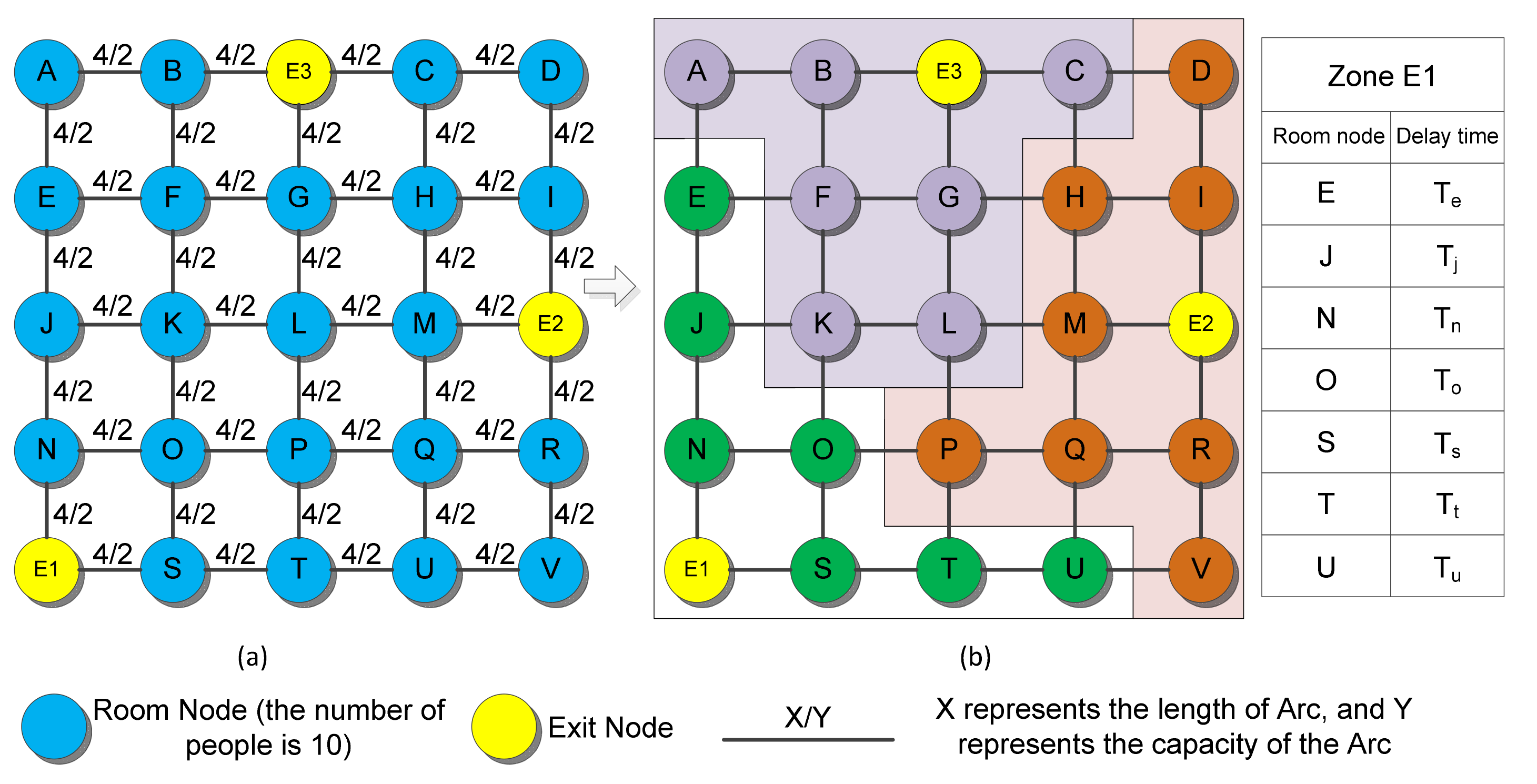



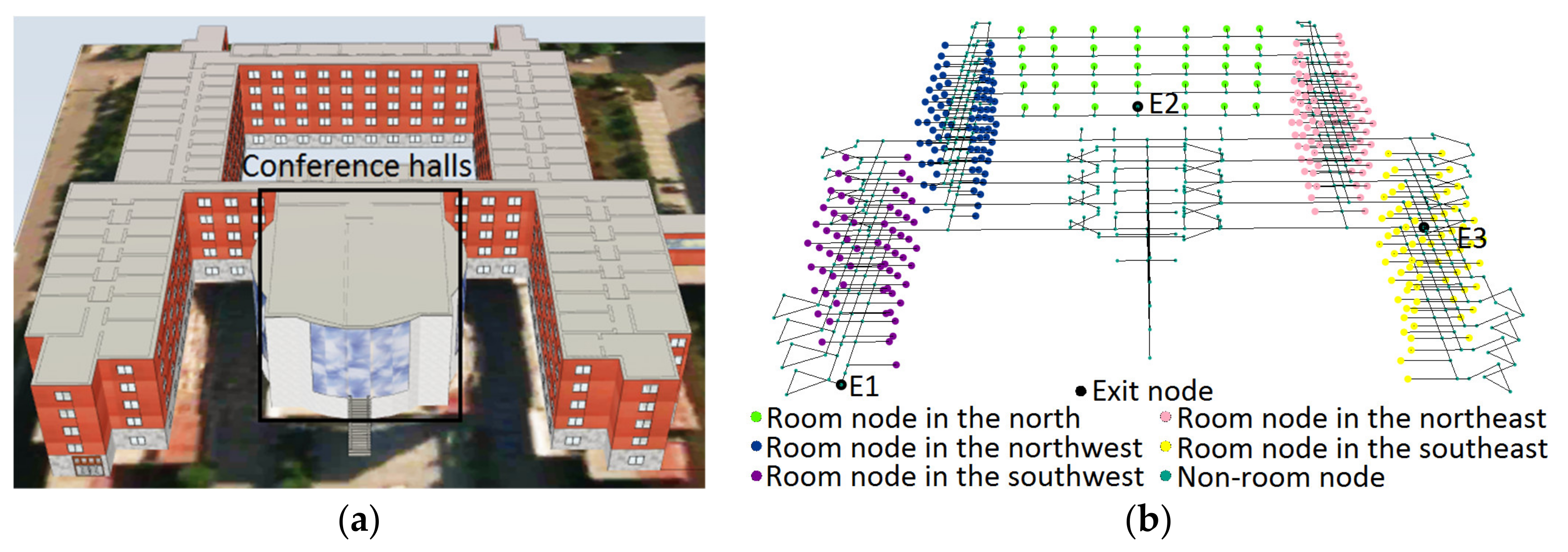
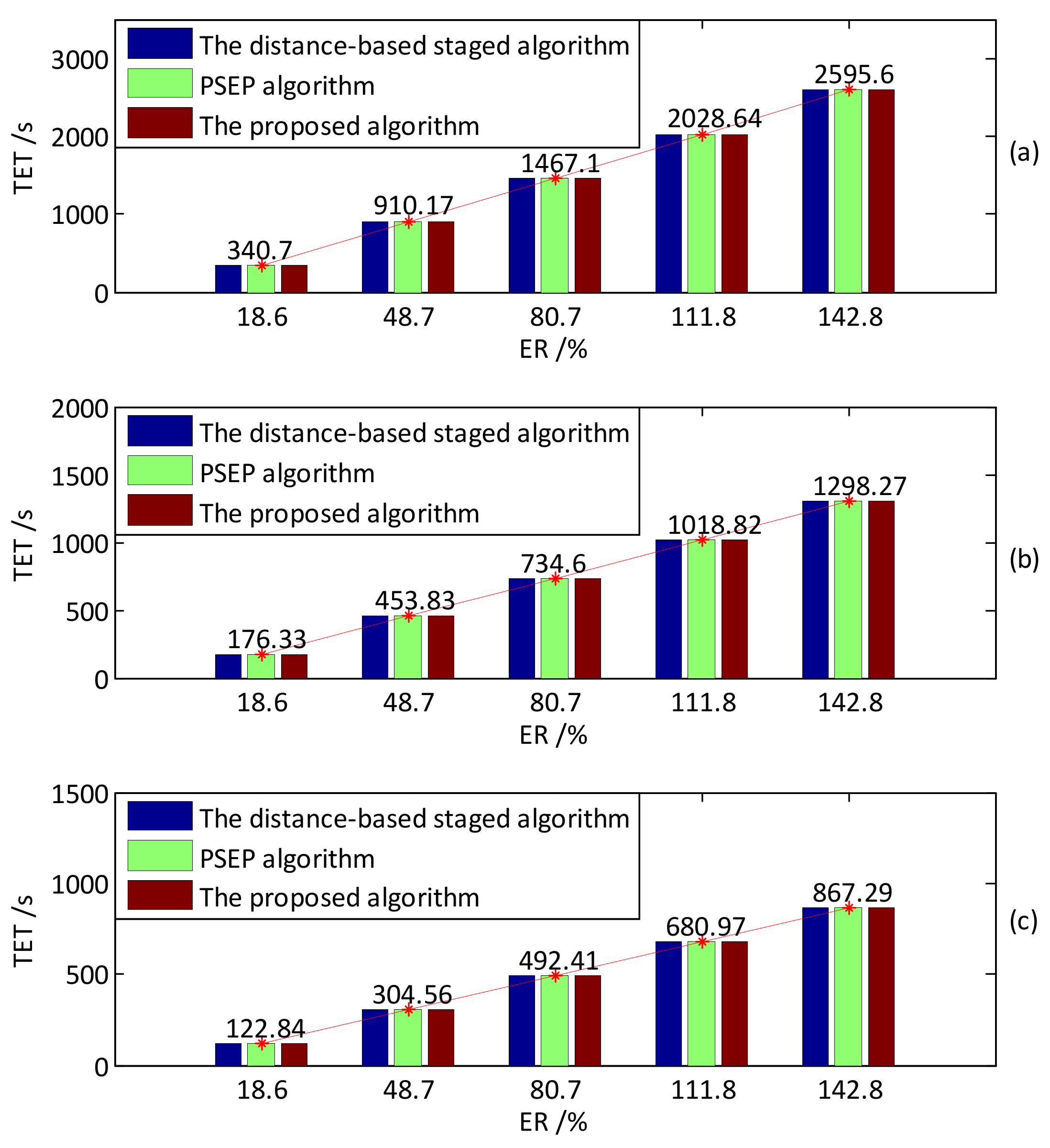


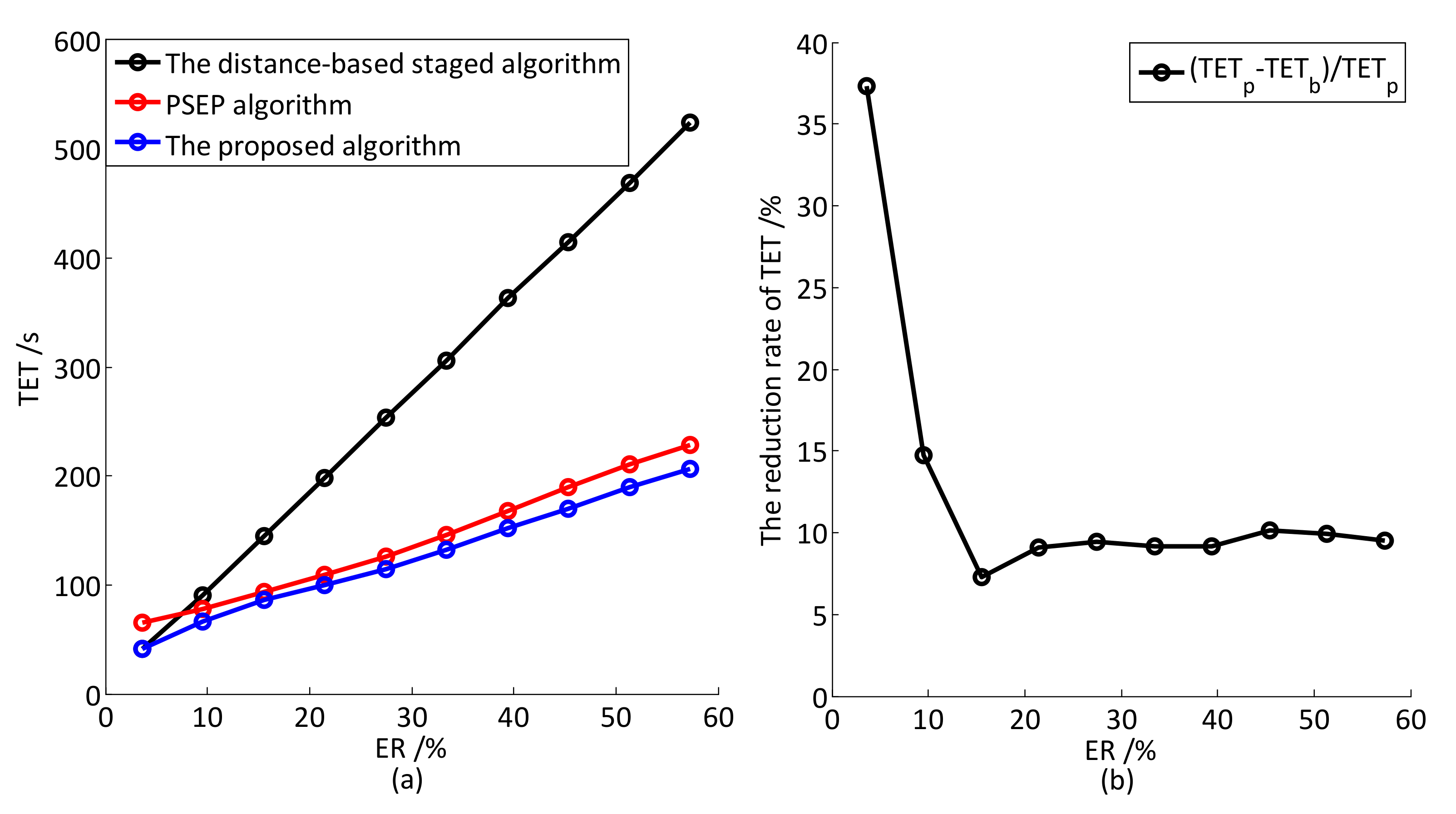
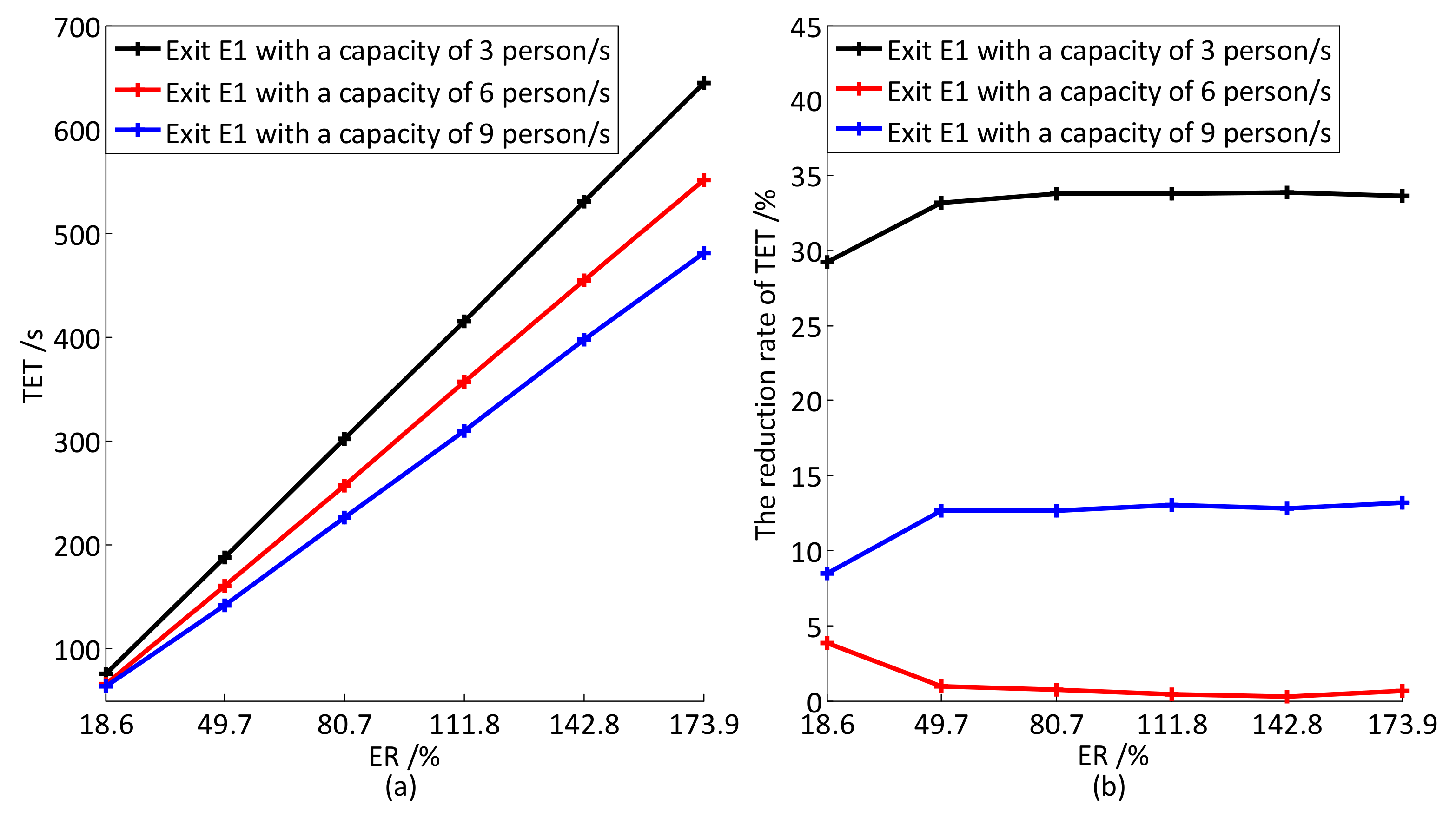
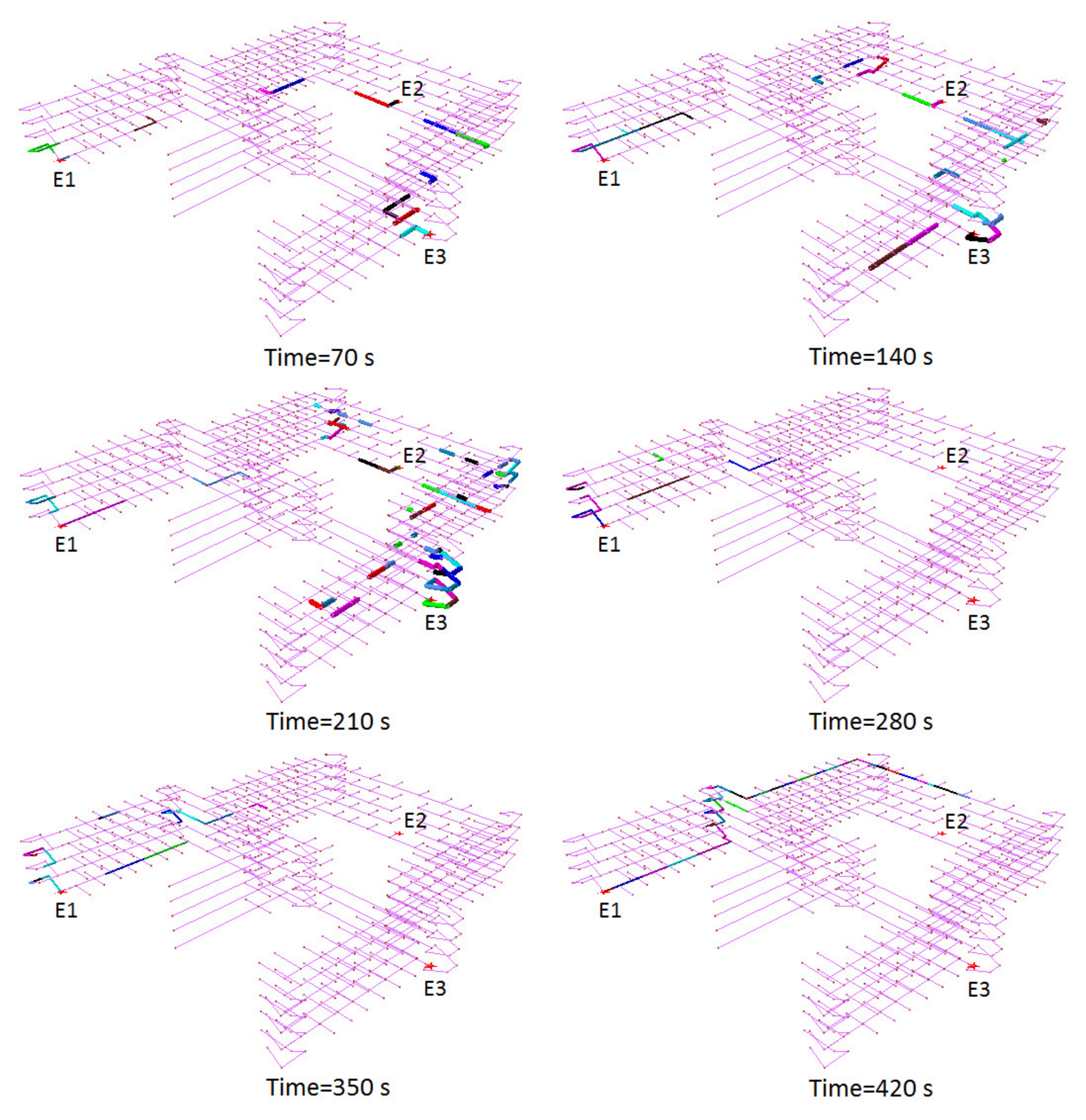
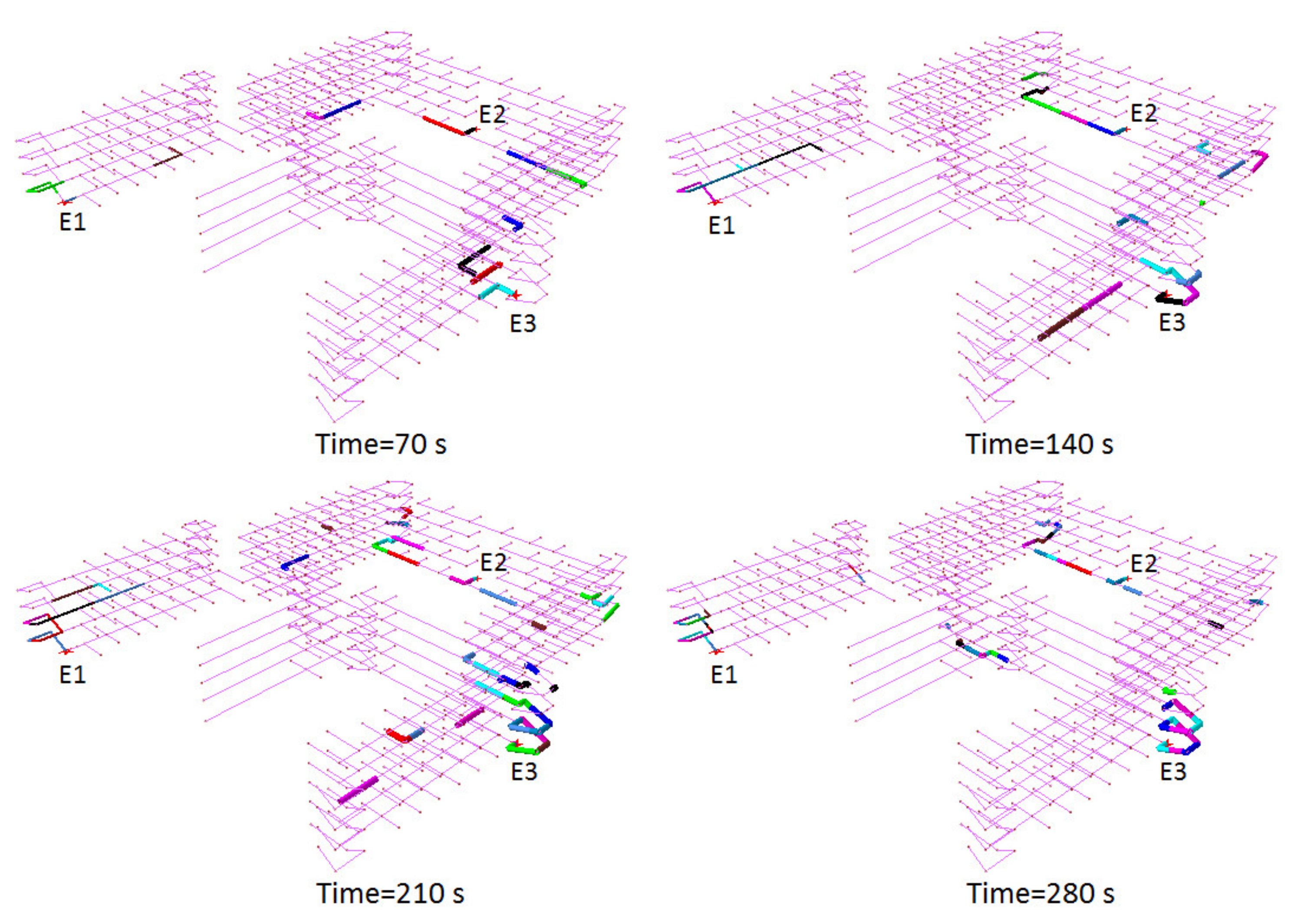
| Variable | Meaning |
|---|---|
| the escape speed of the group | |
| the traffic flow of route of group | |
| the arc between node and node | |
| the capacity of | |
| the capacity of exit for group | |
| the route of group | |
| the path length of group | |
| the number of groups in the same zone | |
| the number of zones | |
| the number of occupants in group | |
| the delay time of group in zone | |
| the evacuation time of group | |
| the response time of group in zone | |
| the travel time of group in zone | |
| the queueing time of group in zone | |
| the evacuation time in zone | |
| the occupancy time of exit | |
| the shortest TET | |
| the number of nodes in the route network | |
| the number of branch nodes |
| Floor | Southwest | Southeast | Northwest | Northeast | North | The Number of Nodes |
|---|---|---|---|---|---|---|
| 1 | 13 | 14 | 17 | 17 | 6 | 67 |
| 2 | 13 | 14 | 17 | 17 | 7 | 68 |
| 3 | 13 | 14 | 17 | 17 | 7 | 68 |
| 4 | 13 | 14 | 16 | 17 | 7 | 67 |
| 5 | 13 | 14 | 17 | 17 | 7 | 68 |
| Direction | Southwest | Southeast | Northwest | Northeast | North |
|---|---|---|---|---|---|
| 8.24% | 0 | 12.70% | 25.13% | 1.63% | |
| 16.79% | 19.97% | 21.05% | 34.29% | 19.21% | |
| −7.26% | 0 | −0.43% | −5.02% | −0.51% | |
| 35.22% | 50.95% | 14.47% | 31.92% | 23.28% |
| Group Size | (1, 5) | (6, 10) | (11, 15) | (16, 20) | (21, 25) | (26, 30) | (31, 35) | (36, 40) | (41, 45) | (46, 50) |
|---|---|---|---|---|---|---|---|---|---|---|
| ER/% | 3.58 | 9.55 | 15.52 | 21.49 | 27.46 | 33.44 | 39.41 | 45.38 | 51.35 | 57.32 |
| 1 | 1 | 1 | 1 | 1 | 1 | 1 | 1 | 1 | 1 | |
| 0.3766 | 0.3769 | 0.3175 | 0.2650 | 0.2237 | 0.2190 | 0.2127 | 0.2242 | 0.2227 | 0.2039 | |
| 1 | 0.5078 | 0.1740 | 0.0955 | 0.0494 | 0.0540 | 0.0522 | 0.0538 | 0.0575 | 0.0460 |
| Group Size | ER/% | The Capacity of Exit E1 | ||
|---|---|---|---|---|
| (1,5) | 18.6 | 3 | 0.3790 | 0.0277 |
| 6 | 0.1136 | 0.0556 | ||
| 9 | 0.1716 | 0.0819 | ||
| (6,10) | 49.7 | 3 | 0.4253 | 0.0211 |
| 6 | 0.0670 | 0.0534 | ||
| 9 | 0.2096 | 0.0802 | ||
| (11,15) | 80.7 | 3 | 0.4321 | 0.0204 |
| 6 | 0.0657 | 0.0556 | ||
| 9 | 0.2080 | 0.0786 | ||
| (16,20) | 111.8 | 3 | 0.4327 | 0.0202 |
| 6 | 0.0651 | 0.0594 | ||
| 9 | 0.2093 | 0.0749 | ||
| (21,25) | 142.8 | 3 | 0.4332 | 0.0198 |
| 6 | 0.0646 | 0.0604 | ||
| 9 | 0.2117 | 0.0794 | ||
| (26,30) | 173.9 | 3 | 0.4333 | 0.0244 |
| 6 | 0.0667 | 0.0571 | ||
| 9 | 0.2114 | 0.0755 |
| ID of Exits | E1 | E2 | E3 | |
|---|---|---|---|---|
| PSEP algorithm | The number of groups | 138 | 88 | 112 |
| The number of occupants | 1451 | 1469 | 1501 | |
| Evacuation time/s | 487.17 | 250.11 | 254.27 | |
| The proposed algorithm | The number of groups | 67 | 110 | 161 |
| The number of occupants | 879 | 1770 | 1772 | |
| Evacuation time/s | 296.50 | 300.28 | 299.43 | |
Publisher’s Note: MDPI stays neutral with regard to jurisdictional claims in published maps and institutional affiliations. |
© 2021 by the authors. Licensee MDPI, Basel, Switzerland. This article is an open access article distributed under the terms and conditions of the Creative Commons Attribution (CC BY) license (https://creativecommons.org/licenses/by/4.0/).
Share and Cite
Han, L.; Gong, C.; Gu, L.; Qiao, H.; Zhang, A.; Liu, M. A Multi-Zone Staged Indoor Emergency Evacuation Algorithm Based on Time Equalization. ISPRS Int. J. Geo-Inf. 2021, 10, 499. https://doi.org/10.3390/ijgi10080499
Han L, Gong C, Gu L, Qiao H, Zhang A, Liu M. A Multi-Zone Staged Indoor Emergency Evacuation Algorithm Based on Time Equalization. ISPRS International Journal of Geo-Information. 2021; 10(8):499. https://doi.org/10.3390/ijgi10080499
Chicago/Turabian StyleHan, Litao, Cheng Gong, Lei Gu, Hu Qiao, Aiguo Zhang, and Mengfan Liu. 2021. "A Multi-Zone Staged Indoor Emergency Evacuation Algorithm Based on Time Equalization" ISPRS International Journal of Geo-Information 10, no. 8: 499. https://doi.org/10.3390/ijgi10080499
APA StyleHan, L., Gong, C., Gu, L., Qiao, H., Zhang, A., & Liu, M. (2021). A Multi-Zone Staged Indoor Emergency Evacuation Algorithm Based on Time Equalization. ISPRS International Journal of Geo-Information, 10(8), 499. https://doi.org/10.3390/ijgi10080499






